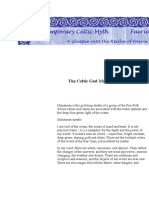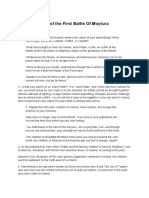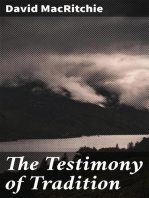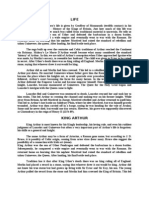Morgana's Alter Ego - Doc 1
Morgana's Alter Ego - Doc 1
Uploaded by
matchmaker016Copyright:
Available Formats
Morgana's Alter Ego - Doc 1
Morgana's Alter Ego - Doc 1
Uploaded by
matchmaker016Original Title
Copyright
Available Formats
Share this document
Did you find this document useful?
Is this content inappropriate?
Copyright:
Available Formats
Morgana's Alter Ego - Doc 1
Morgana's Alter Ego - Doc 1
Uploaded by
matchmaker016Copyright:
Available Formats
Hope Stewart BISCLA 384: Literature and Popular Genre The Supernatural J.
. Milutis Research Paper March 9, 2012 Morganas Alter Ego: as given to her by many different authors (she is known as Morgaine, Morgan, Morgain, Morgen, Morgan le Fay, and Morgana, but for the purposes of this paper Morgana will be the only name I use) Morgana, the well known enchantress, is known throughout history as being the troublesome bad girl in Arthurian legend. Charles Moorman even went as far as to compile a list of her common characteristics which are as follows: (1) she is associated with an Otherworld paradise, (2) she possesses a magical healing power, (3) she is the half-sister of Arthur, (4) she lures knights into her Otherworld abode, (5) she has the ability to change the shapes of things, (6) she possesses great beauty, (7) she hates Guinevere, (8) she tests the fidelity and honor of individuals, (9) her actions are usually directed against Arthur, and (10) she possesses the power of prophecy (Moorman, 84). As you can see these arent all bad characteristics; however, Morgana seems to embody the worst ones and one very rarely catches a glimpse of her good features in the traditional older Arthurian texts. One of her rarer moments is when she takes Arthur to the island of Avalon as he is dying and has a few touching words with him. The many faces of Morgana are the
primary foci of this paper and the goal is to discover and discuss why so many versions of her exist and compare and contrast their features. The Mists of Avalon contains a considerably different version of Morgana; she is a softer, kinder person. In this story you see her grow into a young woman and learn the art of the goddess from the Lady of the Lake, Viviane, as well as managing her visions. Arthur is introduced at a very young age and was taught swordsmanship and fighting from Merlin along with receiving the gift of his wisdom. Something to note from this story, as opposed to other stories, is that Merlin plays a very small role. You see him in the beginning of the story, but he dies off early in the story due to the feelings of magic leaving his body which leaves him progressively weaker and weaker. Other stories like Excalibur and even the Disney movie The Sword and the Stone describe him as King Arthurs counsel and guidance. In Le Morte DArthur and Suite du Merlin Merlin is shown teaching Morgana magic and leading her unintentionally down an evil path. Then again this story is primarily focused on the feminine aspects of Arthurian legend with a twist so it would be expected that male details would be minimalized or edited out. Even Arthurs character in Mists isnt talked about as much as you might think; the character of the Lady of the Lake, Viviane, seems to take the place many think Arthur would hold. Magic/the Goddess has developed into its own character throughout the story as Morgana is learning the way of the Goddess. With each day grasping more and more characteristics such as harnessing ones mind over nature and controlling the mists between both worlds.
The huge difference in The Mists of Avalon and traditional Arthurian legend is that Morgana does everything in her power and the power of the Goddess to help her younger brother. She has a deep sisterly love for him and for a short time a carnal lustful love as well. It isnt until shortly after The Great Marriage that she becomes aware that the hunter is her half-brother, Arthur. She leaves the persona of the evil sorceress and starts to provide a positive spin to the age old character. In the end of the story the reader sees that Morgana is inadvertently a hero and the one that gets King Arthur out of his slump and out on the battlefield to fight his last battle against the Saxons and more importantly his illegitimate son, Mordred, the result of The Great Marriage ritual with Morgana. Le Morte DArthur portrays her like the evil stepsisters or stepmother you see in Cinderella except adds magic into the mix and a taste for the death of her half-brother. She is both evil and dark and with each day seems to keep growing deeper into evil ways. The best description of her character in DArthur is as follows: Morgan le Fay [Morgana], Arthurs half-sister, is the chief source of baleful magic in the Morte Darthur. Unlike her analogue in the Prose Lancelot, she is her never successful in her designs. Although we are engagingly informed that she learned her necromancy in a nunnery, she is closer to pure myth than are any of the other characters. Hostile to Arthur throughout his life she turns up at the end as an affectionate and beneficent healer; the paradox is explained in her possible derivation from two antithetical Celtic goddesses, the Morrigan, who was an Irish
battle-goddess noted for her ability to incite destructive activities, to prophesy, to create effects of nature and to shape-shift; and the benign white goddess Matrona or, possibly, the water-born Morgen (Whitaker, 58). Whitakers short and to the point description points out not only the good and the bad but also gives some history on where she comes from. The aspect of religion has a strong back-story in The Mists of Avalon. There are the Christians and those that follow the ways of the Goddess. These are two very different religions, but Arthur attempts to unite them in his reign, which is supported by his wife and more importantly his marriage to a Christian. Kristina Hildebrand gave an excellent description of how each type of reader is affected by reading Mists that just had to be included: The male reader may indeed experience a sense of alienation similar to that felt by the female reader of androcentric texts. Nevertheless, the male reader may approach The Mists of Avalon through the positive hermeneutic suggested by Schweickart for female readers: by overturning the gendering of the characters, the male reader may identify with Morgaine [Morgana] and [recuperate] the utopian moment. By ignoring the inappropriateness of the gender roles and reading the text as a woman, the male Neo-Pagan reader would find a text which explores and formulates his own religious views. Such a reading would make the readers faith more central than his gender.
The portrayal of men in The Mists of Avalon, would, however, make it necessary for the male reader to participate in the reading of men as Other, thereby alienating himself(Hildebrand, 123). Similarly, the female response to the reading is based on the females preconceived notions and determines who she more closely relates to and why. This is important for religion aspects as those that are Christian or have any religious background may side with one character more than the other. Before reading Hildebrands article the lines between who I sided with were a lot fuzzier. Coming from a Christian perspective I had a stronger urge to side with Morgana than with Guinevere as I felt Guinevere was very wishy-washy and two-faced. She would say one thing and do another throughout The Mists of Avalon. She was portrayed as a very wimpy character. The Tales of King Arthur also reiterates the evil sorceress persona as Arthur entrusts his magic scabbard to his half-sister Morgan le Fay [Morgana]; she secretly makes a copy, which she returns to the king, and gives the original to her lover Accolon, a knight of the Round Table (Archibald and Edwards, 140). Shortly thereafter Morgana orchestrates a blind fight between the two of them. Her plan gets foiled by the Lady of the Lake who returns the sword/scabbard to Arthur who in turn fatally wounds his opponent Accolon. The term enchantress, used near the beginning of this paper, is different yet the same in meaning as the term sorceress which I have used in association with Le Morte DArthur and related texts. Sorceress has evil, negative
connotations; whereas, enchantress sounds more mystical. Carolyne Larrington described enchantresses as not being witches, they are sexually attractive women who employ magic for their own ends, not in the service of Satan. Always alluring, intelligent and independent, sometimes they support the aims of Arthurian chivalry, at other times they can be hostile and pettyminded (Larrington, 2). However, Catherine Batt described that, Morgains [Morgana] lot is of the devil, and her increasing ugliness registers her carnal desire and search for illicit knowledge (Batt, 65). These two descriptions seem to differ, yet both describe Morgana as there are many versions of her. The first description, however, describes both the good and bad and is easily more thought provoking. Villainess brings to mind images of Cruella de Ville and The Queen in Snow White who have been known in more recent years as the villainesses of our day. Picturing Morgana as a villainess in those regards gives the reader a much better visual image to associate her with and something a bit more current to compare to. There is also the media portrayal of Morgana in the popular BBC channels show Merlin. This show is a retelling of what life would have been like for a young Arthur and young Merlin. This also includes all the other common characters in the Arthurian legend as well as a few extras. Morgana is cast as Uthers ward and doesnt know she is Uthers illegitimate daughter, nor of magical descent. Merlin seems to tweek The Mists of Avalon and combines the characters Morgana and Mordred (her illegitimate son with Arthur) to make her character more prominent. Merlin follows pieces of The Mists of
Avalon as well as casting Morgana as the villainess as Arthurian legend primarily dictates. They did take liberties with Morgause as in Mists she is Morganas aunt, but in this television show shes her sister and a very powerful sorceress which she didnt seem to be in Mists. Morganas goal is to have her place as the rightful queen of Camelot, much like Mordred did in Mists. The show does a great job of recreating the Arthurian legend in a new and reformed way much like The Mists of Avalon did to enact the feminist side of Camelot. Side note: The prominent women in Arthurian legend have magical descent except for Guinevere and wives of Knights of the Round Table. The very opposite is true for the male side of Arthurian legend where very few male characters, other than the wizard Merlin, are of magical descent. This seems to be the norm for the Arthurian legend; there wasnt much to backup this theory but was considered worthwhile to point out. In mentioning Guinevere most stories portray Morgana absolutely hating and despising Guinevere; however, in Mists it seems to be the other way around with Guinevere going back and forth between loving and hating her and her religion. Near the end of the story you see Morgana holding Guinevere after the incident with Lancelot. In the example of Guinevere and Morgana it is remarkable how much a person can change based on the person telling this story. With most stories the stories are set in stone and the concrete facts never change; Arthurian legend, however, bends and breaks this time and time again. Very few things stay true as a whole across the board. The
concrete solids are that King Arthur is king and that one day his kingdom will be brought down by an enemy much like the character Mordred plays throughout Arthurian history. The real question is -- Which Morgana is the right one and is there actually a correct one? The answer to this is that there isnt a right or wrong version; they all boil down to the same basic person. The basis for the older stories is that the evil villainess almost always has a hidden agenda with Arthur or the charming enchantress who everyone seems to have a soft spot for. Merlins portrayal of Morgana may be the most exact as she starts out as the charming enchantress and over the course of a few seasons grows into her magic and learns more about her family and the secrets associated with them and gradually changes into the dark and evil villainess you see in the current season.
Works Cited Archibald, Elizabeth, and A. S G Edwards. A Companion to Malory. Woodbridge, Suffolk, UK; Rochester, N.Y.: D.S. Brewer, 1996. Print. Batt, Catherine. Malory's Morte Darthur : Remaking Arthurian Tradition. New York: Palgrave, 2002. Print. Benson, Larry Dean,. Malory's Morte Darthur. Cambridge: Harvard UP, 1976. Print. Bradley, Marion Zimmer. The Mists of Avalon. New York: Knopf, 1983. Print. Engelking, Tama Lea. "Renee Vivien and The Ladies of the Lake." Nineteenth Century French Studies 30.3 (2002): 363-80. Print. Fries, Maureen, Bonnie Wheeler, and Fiona Tolhurst. On Arthurian Women : Essays in Memory of Maureen Fries. Dallas, TX: Scriptorium, 2001. Print. Hildebrand, Kristina. The Female Reader at the Round Table : Religion and Women in Three Contemporary Arthurian Texts. Thesis. Uppsala: Ubsaliensis S. Academiae : Disbributor, Uppsala University Library, 2001. Print. Larrington, Carolyne. King Arthur's Enchantresses : Morgan and Her Sisters in Arthurian Tradition. London; New York: I.B. Tauris, 2006. Print.
Lumiansky, R. M. Malory's Originality; a Critical Study of Le Morte Darthur. Baltimore: Johns Hopkins, 1964. Print. Merlin. The Complete First, Second, Third, and Fourth Season. Dir. Julian Murphy, Johnny Capps, Jake Michie, Julian Jones, Howard Overman, Ben Vanstone, Ed Fraiman, James Hawes, Jeremy Webb, Dave Moore, Stuart Orme, Colin Morgan, Bradley James, Anthony Stewart, Head, Richard Wilson, Katie McGrath, Angel Coulby, John Hurt, Michelle Ryan, Shine Limited (Firm),, British Broadcasting Corporation.,, BBC Worldwide Americas, Inc.,, and Warner Home Video (Firm),. BBC, 2010. DVD. Moorman, Charles. The Book of Kyng Arthur; the Unity of Malory's Morte Darthur. [Lexington: University of Kentucky, 1965. Print. Rhys, John. Studies in the Arthurian Legend. New York: Russell & Russell, 1966. Print. Whitaker, Muriel A. Arthur's Kingdom of Adventure : The World of Malory's Morte Darthur. Cambridge [Cambridgeshire]; Totowa, N.J.: D.S. Brewer ; Barnes & Noble, 1984. Print.
You might also like
- March Form 2Document1 pageMarch Form 2Jack PhanNo ratings yet
- Granblue Fantasy - Graphic Archive 5Document376 pagesGranblue Fantasy - Graphic Archive 5Carlos BacarraNo ratings yet
- Celtic DeitiesDocument37 pagesCeltic DeitiesAmber McDonaldNo ratings yet
- The MorriganDocument1 pageThe MorriganLuke MarreNo ratings yet
- Fairycraft - Following The Path of Fairy WitchcraftDocument2 pagesFairycraft - Following The Path of Fairy WitchcraftSamira Aires0% (2)
- AG0262 - Heirs To Merlin - The Stonehenge TribunalDocument170 pagesAG0262 - Heirs To Merlin - The Stonehenge Tribunalxelif100% (6)
- Morgan 2Document15 pagesMorgan 2Volkan VVolkanNo ratings yet
- Prophecy of The Seeress: Trans. Irmin VinsonDocument32 pagesProphecy of The Seeress: Trans. Irmin VinsonNora BoruNo ratings yet
- The Red DragonDocument3 pagesThe Red DragonAndy Zemba100% (1)
- Runes of Andraste or AndredDocument40 pagesRunes of Andraste or AndredDaniel English100% (4)
- Celtic Lore (Needs Pruning)Document383 pagesCeltic Lore (Needs Pruning)Casey J. MurphyNo ratings yet
- King Arthur and His Knights-George GibsonDocument10 pagesKing Arthur and His Knights-George GibsonНастя Костенко100% (1)
- Morgan Le FayDocument17 pagesMorgan Le Fayfirstname lastnameNo ratings yet
- By Casenave Julieta, Espino Evangelina, Godoy Juan Ignacio, Lopez Jay Sara and Vitale Gimena ValentinaDocument3 pagesBy Casenave Julieta, Espino Evangelina, Godoy Juan Ignacio, Lopez Jay Sara and Vitale Gimena ValentinaGimena Valentina VitaleNo ratings yet
- Manannan Mac LirDocument5 pagesManannan Mac LirblissblissNo ratings yet
- The Terror of The Night and The Morrigai PDFDocument28 pagesThe Terror of The Night and The Morrigai PDFJake McIvryNo ratings yet
- Celtic Mythology Is The Mythology of Celtic PolytheismDocument5 pagesCeltic Mythology Is The Mythology of Celtic PolytheismReaKaminariNo ratings yet
- AthenaDocument6 pagesAthenaapi-344996216No ratings yet
- Goddesses: Airmid Aine BadbhDocument1 pageGoddesses: Airmid Aine BadbhCelticRoseNo ratings yet
- Lughnasadh Ritual: PositionsDocument8 pagesLughnasadh Ritual: PositionsmiriNo ratings yet
- OghamDocument2 pagesOghamTimothee100% (1)
- Report: HephaestusDocument16 pagesReport: HephaestusMichelle Anne Atabay100% (1)
- The First Battle of MoyturaDocument18 pagesThe First Battle of MoyturamiriNo ratings yet
- The Celtic Elements in The Lays of PDFDocument61 pagesThe Celtic Elements in The Lays of PDFVictor informatico100% (1)
- HlínDocument3 pagesHlíndzimmer6No ratings yet
- Celtic Tree WorshipDocument3 pagesCeltic Tree WorshipnieotyagiNo ratings yet
- CGW Aug NewsletterDocument18 pagesCGW Aug NewsletterLady HekateShadowMoonfire100% (1)
- Worship and Spirituality During and Between The Asatru HolidaysDocument4 pagesWorship and Spirituality During and Between The Asatru HolidaysbowlahNo ratings yet
- Ella Young - PoemsDocument48 pagesElla Young - PoemsRaphael888No ratings yet
- Deity Worship (Eng)Document4 pagesDeity Worship (Eng)geeta GNo ratings yet
- The Role of The Morrigan in The Cath MaiDocument10 pagesThe Role of The Morrigan in The Cath MaimiriNo ratings yet
- Wiccan SummoningDocument2 pagesWiccan SummoningShayne WeckertNo ratings yet
- Fairy Faith and ChangelingsDocument8 pagesFairy Faith and ChangelingsDouglas R. BissonNo ratings yet
- Giants' Place-NamesDocument4 pagesGiants' Place-NamesVarious TingsNo ratings yet
- Dark Goddesses PDFDocument3 pagesDark Goddesses PDFJulie SmithNo ratings yet
- Lilith Feminine Demons and The Challenge PDFDocument1 pageLilith Feminine Demons and The Challenge PDFCiprian Laurentiu CazanelNo ratings yet
- Trees and SabbatsDocument39 pagesTrees and SabbatsGift M HlanguNo ratings yet
- Imbolc Ritual, February 2: MaterialsDocument6 pagesImbolc Ritual, February 2: Materialsmorrigan53No ratings yet
- Celtic Druidism - History & MythsDocument3 pagesCeltic Druidism - History & Mythsben0% (1)
- Old Europe GoddessDocument11 pagesOld Europe GoddessConi Vergara Cáceres100% (1)
- Druids Then and NowDocument13 pagesDruids Then and NowGas TronomNo ratings yet
- Odin StoneDocument20 pagesOdin Stonescribble108No ratings yet
- 01 Azure Dragon PalaceDocument21 pages01 Azure Dragon Palacevandasayer100% (1)
- Heathen Gods and Rites - A Brief Introduction To Our Ways of Worship and Main DeitiesDocument2 pagesHeathen Gods and Rites - A Brief Introduction To Our Ways of Worship and Main DeitiesMax anykeyNo ratings yet
- Apollo: by Ron LeadbetterDocument61 pagesApollo: by Ron LeadbetterAshvin WaghmareNo ratings yet
- Guinevere: The Lady in White: Three Harmful Blows of The Island of Britain: The Second Gwenhwyfach Struck UponDocument11 pagesGuinevere: The Lady in White: Three Harmful Blows of The Island of Britain: The Second Gwenhwyfach Struck UponKassandra HechiceraNo ratings yet
- Adf CosmologyDocument5 pagesAdf Cosmologysamanera2No ratings yet
- The Underworld Initiation of King Arthur by Morgan The FaeDocument6 pagesThe Underworld Initiation of King Arthur by Morgan The FaeClarence100% (1)
- The Golden HornsDocument170 pagesThe Golden HornsFamespeare100% (1)
- MacCULLOCH, JOHN ARNOTT (1930) Eddic Mythology. CHAPTER 33 COSMOGONY AND THE DOOM OF THE GODSDocument53 pagesMacCULLOCH, JOHN ARNOTT (1930) Eddic Mythology. CHAPTER 33 COSMOGONY AND THE DOOM OF THE GODSAnthony McIvorNo ratings yet
- Celtic Mythology ReportDocument25 pagesCeltic Mythology Reportalliah de jesusNo ratings yet
- Celts - Crystalinks (17p)Document17 pagesCelts - Crystalinks (17p)Virginio MantessoNo ratings yet
- Representations of The Death Myth in Celtic LiteratureDocument10 pagesRepresentations of The Death Myth in Celtic LiteraturecristinadrNo ratings yet
- The Art of Morrigan (Hardcover)Document72 pagesThe Art of Morrigan (Hardcover)Emily ClarksonNo ratings yet
- Yggdrasil: Old Norse Cosmos Nine WorldsDocument25 pagesYggdrasil: Old Norse Cosmos Nine WorldsNick Jbn100% (1)
- Horned GodDocument1 pageHorned GodTaylor BesedaNo ratings yet
- Táin Bó CuailgneDocument4 pagesTáin Bó CuailgneIrina-Oana StanciuNo ratings yet
- Witch TrialsDocument65 pagesWitch TrialsAmaani AtaullahNo ratings yet
- WITCH Baba YagaDocument2 pagesWITCH Baba YagahybridofhateNo ratings yet
- Wikipedia - Triple DeityDocument8 pagesWikipedia - Triple DeitylimentuNo ratings yet
- HecateDocument4 pagesHecateashvinNo ratings yet
- King ArthurDocument8 pagesKing ArthurMark Anthony S. Castillo100% (2)
- Le Morte D'arthurDocument6 pagesLe Morte D'arthurGuilliane GallanoNo ratings yet
- Some Notes On Merlin - C. Scott Littleton and Linda A. MalcorDocument9 pagesSome Notes On Merlin - C. Scott Littleton and Linda A. MalcorMetasepiaNo ratings yet
- King ArthurDocument3 pagesKing ArthurLada BurlakaNo ratings yet
- Merlin 1998Document1 pageMerlin 1998Andang BlanceNo ratings yet
- The Legend - WPS OfficeDocument1 pageThe Legend - WPS OfficeMerlyn TigbabaoNo ratings yet
- Le Morte Darthur Sir Thomas Malory Download PDFDocument61 pagesLe Morte Darthur Sir Thomas Malory Download PDFsojoudtawile100% (3)
- Patsy SpamalotDocument9 pagesPatsy SpamalotsasavujisicNo ratings yet
- Detailed Lesson Plan The Day of Destiny Grade 9Document12 pagesDetailed Lesson Plan The Day of Destiny Grade 9ClariseNo ratings yet
- Le Morte DDocument4 pagesLe Morte DzandaNo ratings yet
- Aurelius Ambrosius - Roots of The Arthurian LegendDocument5 pagesAurelius Ambrosius - Roots of The Arthurian Legendtorrentfreak872No ratings yet
- King ArthurDocument16 pagesKing ArthurAnonymous RhFVRykAoNo ratings yet
- Artoria Pendragon (Saber) - TYPE-MOON Wiki - Fandom3Document1 pageArtoria Pendragon (Saber) - TYPE-MOON Wiki - Fandom3Angel Valenzuela AquinoNo ratings yet
- Literatura GripitoooDocument21 pagesLiteratura GripitoooCamila Yuliza Walter CarranzaNo ratings yet
- The Legend Our Reality of King ArthurDocument2 pagesThe Legend Our Reality of King ArthurAlzira GarciaNo ratings yet
- King Arthur NotesDocument23 pagesKing Arthur NotesJohn Jeiver Obando LeonNo ratings yet
- Contribution of Knights in English LiteratureDocument1 pageContribution of Knights in English LiteratureJanice DollosaNo ratings yet
- King Arthur and Knights of The Round Table Preguntas y RespuestasDocument2 pagesKing Arthur and Knights of The Round Table Preguntas y RespuestasKenni Arnaldo58% (12)
- The Myth of Arthur's Return 2019Document9 pagesThe Myth of Arthur's Return 2019Katelynn ANo ratings yet
- King ArthurDocument6 pagesKing ArthurSalwani AzlinaNo ratings yet
- Michael J. Curley - Geoffrey of Monmouth-Twayne Publishers (1994)Document197 pagesMichael J. Curley - Geoffrey of Monmouth-Twayne Publishers (1994)João Gabriel Teixeira de SousaNo ratings yet
- King Arthur CharactersDocument21 pagesKing Arthur CharactersWilliam Perry100% (2)
- Jason Nolan Unearthing Medieval VampireDocument7 pagesJason Nolan Unearthing Medieval VampireSumruhan GünerNo ratings yet
- Bsee 33 Group 4 Written ReportDocument7 pagesBsee 33 Group 4 Written ReportVelasco, Lindsay Crystal S.No ratings yet
- King UtherDocument3 pagesKing UtherAileen SacayNo ratings yet
- The Day of Destiny - MaloryDocument5 pagesThe Day of Destiny - MaloryAnton Naing100% (5)

























































































